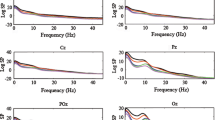Conclusions
-
1.
The study of changes in cross-correlation between potentials from different cortical zones of the human brain during activation associated with intellectual concentration showed that the level of synchronization is in most cases increased. This applies in particular to distant regions of the cortex and it leads to flattening of the gradient of synchronization which exist at rest. During intellectual concentration a stabilization of relations takes place between fluctuations in the degree of synchronization of potentials, as expressed by strengthening of the tendency toward unidirectional shifts in the coefficients of cross-correlation between different cortical regions.
-
2.
Investigation of changes in the spectral characteristics of the EEG of different cortical areas of the left hemisphere led to the conclusion that the changes taking place are parallel: enhancement of low-frequency components (delta-theta-rhythm) and a decrease in the spectral power of the alpha-rhythm. The energy of beta-activity showed no significant change in a state of mental concentration.
-
3.
Enhancement of low-frequency activity during intellectual concentration is accompanied by an increase in the degree of synchronization of fluctuations in its energy. The opposite tendency is observed with respect to the alpha-rhythm, probably because of mechanisms limiting the spread of this type of activity over the cortex.
Similar content being viewed by others
Literature cited
V. V. Bobkova, in: Current Problems in Psychoneurology. Transactions of the Leningrad Psychoneurological Institute [in Russian], No. 38, Leningrad (1966), p. 5.
P. V. Bundzen, in: Problems in Higher Nervous Activity as Applied to Clinical Problems [in Russian], Meditsina, Leningrad (1965), p. 28.
Ya. A. Vasil'ev and V. D. Trush, Dokl. Akad. Nauk SSSR,222, No. 5, 1249 (1975).
N. A. Gavrilova, “The spatial organization of biopotentials of the cerebral cortex in some forms of schizophrenia,” Doctoral Dissertation, Institute of Forensic Psychiatry, Ministry of Health of the USSR, Moscow (1973).
E. A. Golubeva and V. I. Rozhdestvenskaya, Vopr. Psikhol., No. 5, 48 (1969).
T. M. Efremova and V. D. Trush, Zh. Vyssh. Nerv. Deyat.,24, No. 2, 292 (1974).
E. A. Zhirmunskaya, L. G. Makarova, and V. A. Chukhrova, in: Problems in the Pathogenesis, Clinical Picture, and Treatment of Neuroses [in Russian], Medgiz, Moscow (1958), p. 108.
A. M. Zimkina, Fiziol. Zh. SSSR,68, No. 7, 777 (1962).
L. P. Latash, The Hypothalamus, Adaptive Activity, and the Electroencephalogram [in Russian], Meditsina, Moscow (1968).
M. N. Livanov, N. A. Gavrilova, and A. S. Aslanov, Zh. Vyssh. Nerv. Deyat.,14, No. 2, 185 (1964).
M. N. Livanov, N. A. Gavrilova, and V. N. Chemodanov, Neirofiziologiya,2, No. 2, 186 (1970).
M. N. Livanov, The Spatial Organization of Brain Processes [in Russian], Nauka, Moscow (1972).
I. A. Peimer, “Electroencephalographic investigation of higher nervous activity,” Doctoral Dissertation, Leningrad (1960).
L. A. Potulova, in: Functional Organization of Brain Activity [in Russian], Nauka, Moscow (1975), p. 169.
E. N. Semenovskaya, and R. N. Lur'e, Problems in Physiological Optics [in Russian], Vol. 6, Izd. AN SSSR, Moscow-Leningrad (1948), p. 299.
G. A. Sergeev, L. P. Pavlova, and A. F. Romanenko, Statistical Methods of Investigation of the Human Electroencephalogram [in Russian], Nauka, Leningrad (1968).
E. B. Sologub, in: Problems in Spatial Synchronization of Brain Biopotentials [in Russian], Pushchino-on-Oka (1973), p. 124.
T. P. Khrizman and V. N. Zaklyakova, in: Memory and Trace Processes. Abstracts of Proceedings of the 2nd Conference on Problems in Memory and Trace Processes [in Russian], Pushchino-on-Oka (1970), p. 188.
A. N. Shepoval'nikov and M. N. Tsitseroshin, Izv. Leningr. Electrotekh. Inst., No. 162, 88 (1975).
D. B. Lindsley, in: Personality and Behavior Disorders, edited by Hunt, No. 2, Ronald, New York (1944), p. 1033.
A. C. Mundy-Castle, Electroenceph. Clin. Neurophysiol.,7, No. 3, 477 (1951).
A. C. Mundy-Castle, Electroenceph. Clin. Neurophysiol.,9, No. 4, 649 (1957).
L. Sorel, Acta Neurol. Psychiat. Belg.,65, No. 8, 579 (1965).
Author information
Authors and Affiliations
Additional information
Translated from Zhurnal Vysshei Nervnoi Deyatel'nosti, Vol. 27, No. 3, pp. 561–567, May–June, 1977.
Rights and permissions
About this article
Cite this article
Sviderskaya, N.E. Correlation between spatial synchronization and human EEG rhythms. Neurosci Behav Physiol 8, 104–109 (1977). https://doi.org/10.1007/BF01186938
Received:
Issue Date:
DOI: https://doi.org/10.1007/BF01186938



